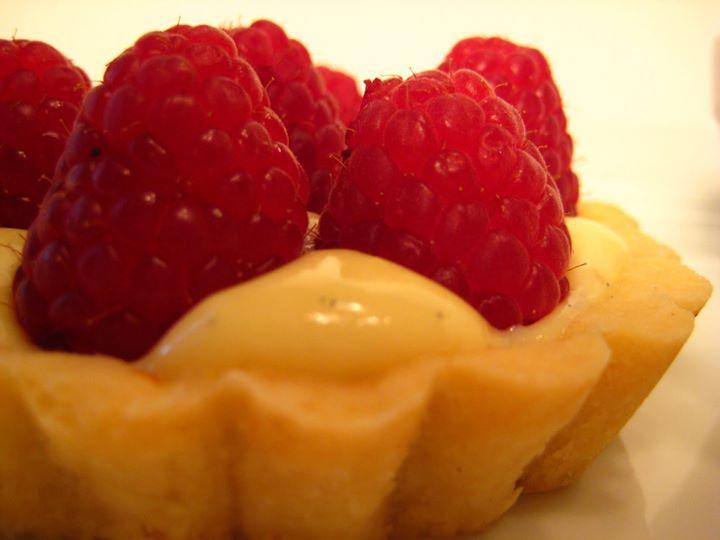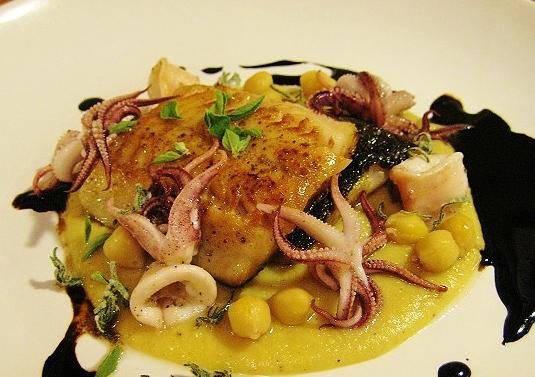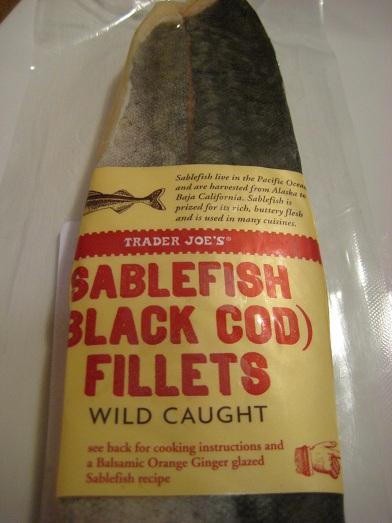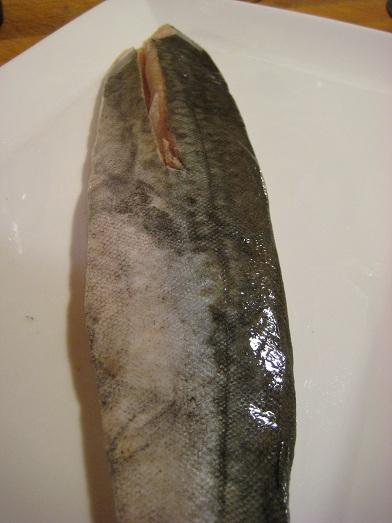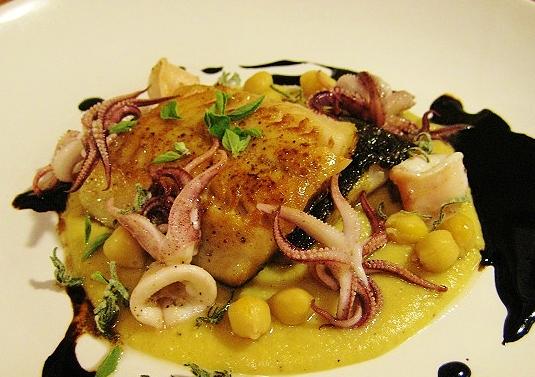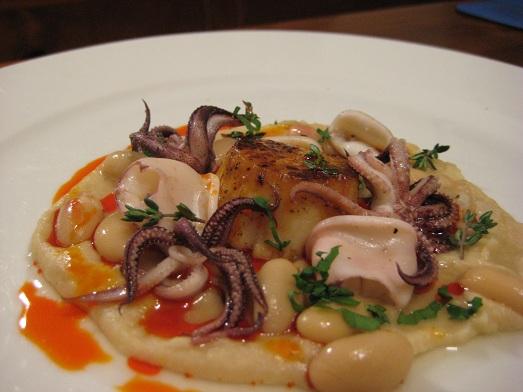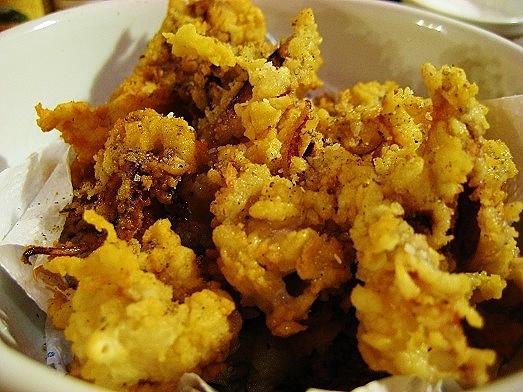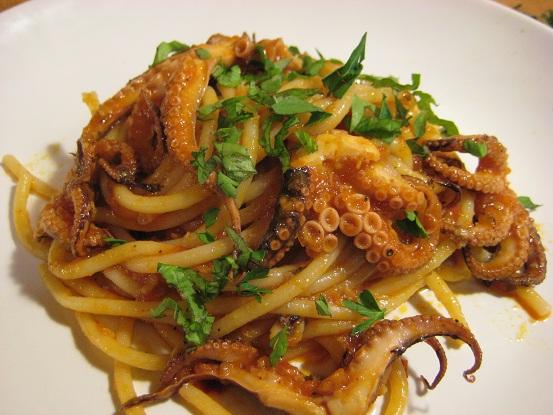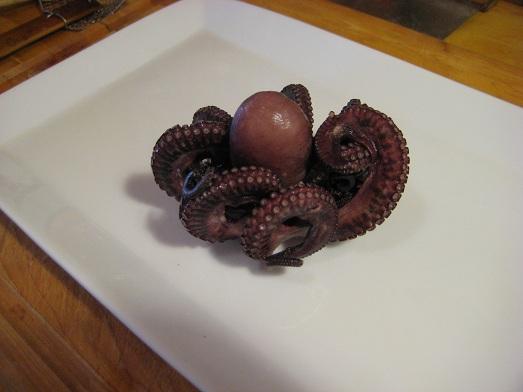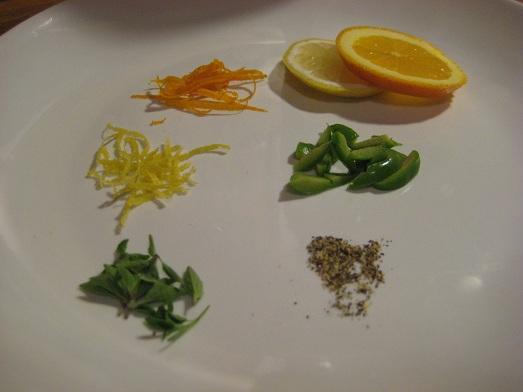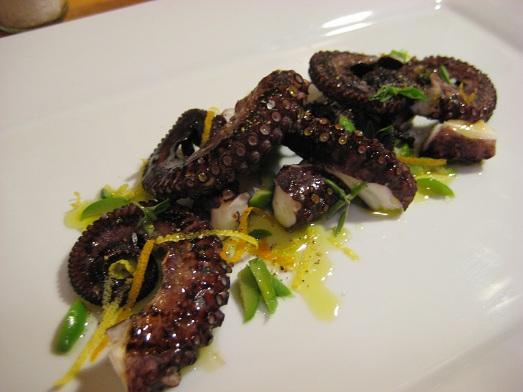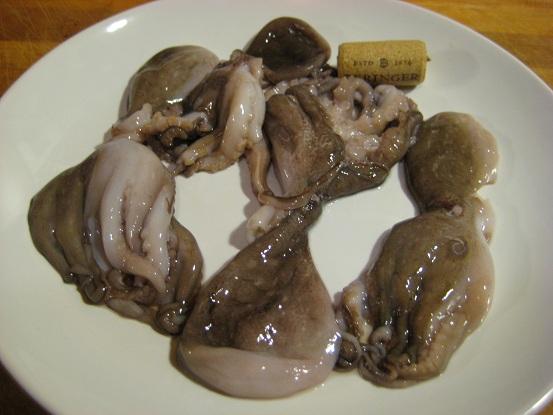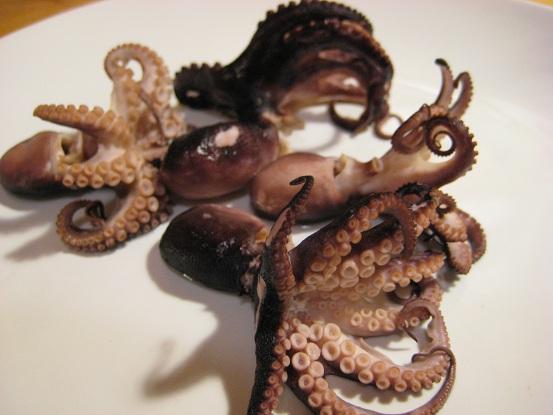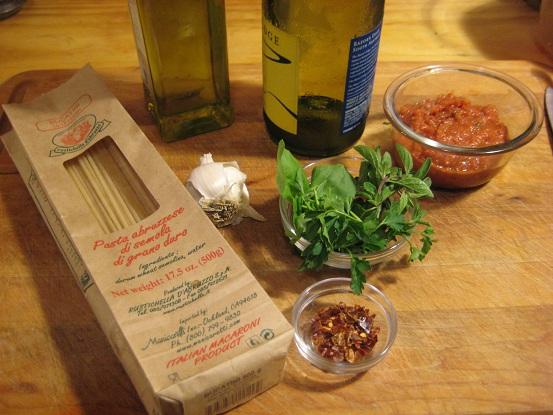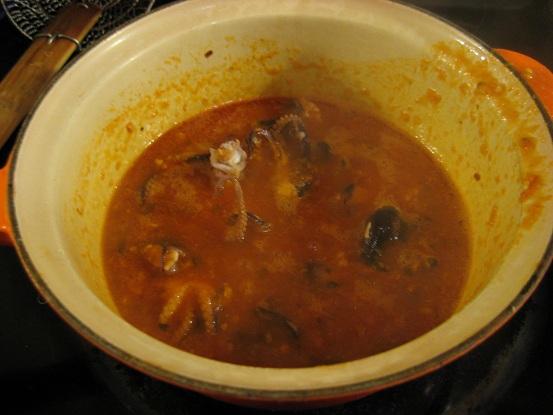-
Posts
5,035 -
Joined
-
Last visited
Content Type
Profiles
Forums
Store
Help Articles
Everything posted by David Ross
-
If I did a Paella with squid or octopus I assume it goes into the rice at the last minute? Would you add other seafood/meat to the paella?
-
That would be great. I've always been intrigued by those little octopus balls, but I've never been adventurous enough to try it.
-
Another squid dish for dinner tonight as part of our Cook-Off (http://forums.egullet.org/topic/144640-cook-off-62-squid-calamari-and-octopus/page-3#entry1912482). Tonight, Sablefish with Seared Squid, Chickpea Puree and Blood Orange Balsamic Syrup-
-
For the second version of Ducasse's dish, I made some big changes- Sometimes I do the dish with cod and in the past I did it with Chilean Sea Bass. I don't buy Chilean Sea Bass any longer due to sustainability issues, and I really didn't want to use cod. A bit boring I thought. Then on a lark I stopped at Trader Joe's and I found this elusive fish in the freezer case: In the Northwest we regard "Black Cod" as highly as the mighty salmon, dungeness and king crabs. The chi-chi name is "sablefish," but whatever you call it is a superior fish--oily, firm flesh and lends itself to a variety of cooking methods. I typically smoke it and serve it in a shallow dish with an Asian soup. Black Cod is also delicious marinated in Alaskan Brewing smoked porter and then slowly braised and served with steamed bok choy. Although it was frozen, I couldn't thank Trader Joe's enough. It's rare that we see black cod fresh even when it's in season. Instead of going with Great Northern beans this time I used dried garbanzo beans. We always called them garbanzo's when I was a kid, but I suppose that "chickpea" sounds a little more contemporary. My thinking was that garbanzo's would be more flavorful than Great Northern beans, (certainly more flavorful than canned), and I'd still be within the French-Medittereanean theme of the Ducasse dish. I considered the flavor of the beans to be more compatible with the black cod and squid. The beans take time, starting with a soak overnight in water. Then on day two you cook the beans for 1 1/2 hours in a pot of water, carrot, onion, celery and unpeeled garlic cloves. Once the beans are tender, step three calls for steeping herbs in the beans off the heat. You don't drain the beans or remove the vegetables at this point, just add the herbs and some olive oil and let it sit off the heat about an hour. The beans pick up just a whisper of the scent of the herbs. Step four calls for processing the beans into a paste and adding only the bean water to thin the sauce. Then the fifth step is to pass the rough puree through a fine sieve. Finally, just before service you heat up the bean puree and season and add a dash of olive oil. I reserved some of the whole garbanzo beans for the garnish. I followed the steps in the recipe fairly strictly this time and the results were evident--a smooth, silky bean puree with pure flavor, (not the diluted flavor of canned beans). The recipe calls for adding a dash of sherry wine vinegar to the bean puree, but this time I took a turn and made a syrup from this wonderful product- Since I wasn't adding the tang of vinegar to the beans, my intention was to use the blood orange balsamic as a garnish but provide the sour boost of vinegar to cut the rich bean sauce and the oil in the black cod. I didn't want to just swig runny vinegar on the fish and the squid, so I reduced it into a syrup, a technique I often use to reduce the acid of the vinegar and bring out the sweetness. The reduced sweet and sour syrup had notes of orange and citrus which married beautifully to the richer elements of the dish. The squid was flash-fried in a hot pan in olive oil for no more than 20 seconds, then tossed in fresh lemon juice. In this dish, the squid adds texture and flavor while staying within the theme of "seafood," and letting the black cod take the centerstage. Although it took a week and the dish underwent some major changes, it was worth the time. Clams could work as the garnish to the black cod, maybe mussels, possibly oysters. But those creatures don't have the texture, delicate flavor and stunning presentation showed by squid. Sablefish with Seared Squid, Chickpea Puree and Blood Orange Balsamic Syrup-
-
My next squid dish was an adaptation of a recipe from Chef Alain Ducasse's "Flavors of France," Fillet of Cod with White Bean Puree and Baby Squid. I've made this dish many times in the past and for the Cook-Off I wanted to show how squid can be an accompaniment in a seafood dish. The cooking of this dish actually started last week, but I wasn't totally satisfied with the results. Over the course of the past week I made some changes to the recipe and made a second attempt tonight. The recipe calls for using dried Great Northern beans, soaked overnight, then cooked the next day for 1 ½ hours with celery, carrot, onion and garlic. After the beans are cooked they are steeped in olive oil, rosemary, sage and some of the bean cooking liquid. Then the herbs and vegetables are taken out and the beans are pureed and passed through a sieve, leaving you with a silky bean puree. On the first attempt I used canned cannellini beans rather than start with dried beans. I didn't follow the Ducasse recipe exactly in terms of cooking the beans since they were canned, and I put chopped herbs into the bean puree rather than letting them steep in the beans. After processing the beans I used them "rustic" rather than passing them through a sieve for a smoother puree. The beans were fairly bland and the thick puree wasnt very photogenic. Ducasse calls for adding a touch of sherry vinegar to the beans, but I substituted red wine vinegar. Not a great alternate because red wine vinegar doesnt have the depth of flavor that sherry vinegar has. Instead of cod I used sea scallops, thinking the rich, buttery flavor would work well with the bean sauce. The scallops were too rich and buttery for the mild squid and the scallops over-powered the delicate bean puree. Taking a cue from an earlier post, I sautéed some dry Spanish chorizo to make a chorizo oil. The thought was to add a bit of smokiness and color to the dish. While I think chorizo oil can work incredibly well when paired with seafood, in this case, the smoke didnt balance with the beans, the acid of the vinegar, the chew of the squid and the rich flavor of the scallops. It was a dish with good intentions and some separate elements that were quite good, but it just didnt come together as one. Seared Sea Scallop with White Bean Puree and Baby Squid- Now on to the second attempt.........
-
I can see how you might think it was more touchy-feely this year. Brooke's multiple phobias-flying in a helicopter for one, I could have done without. But I liked this season the most because they didn't have a bunch of bullies shaving a contestant's head and the Chefs weren't forced into making a cheetos casserole. I thought they did a decent job of spotlighting Pacific Northwest ingredients and focused more on cooking this season. Does Top Chef rise to the level of some of the all-time best food programming on television? No.
-
The chickpeas have been soaking overnight and tonight I'll be using them in a dish where squid is more of a side element rather than the main star of a dish. Not deep-fried this time but flash-fried in a hot skillet paired with a sauce made from the beans and a seared fish filet.
-
After the abysmal failure with the horrific grilled octopus salad, I thought I'd bring it back home for the next dish using a technique I'm fairly good at--deep-frying. As I mentioned in one of my opening posts, we often associate deep-fried calamari as a staple of bar menus--poor renditions of pre-breaded, frozen bits whose primary asset is that it's deep-fried in fat. It's crunchy, greasy and basically bereft of any seafood flavor--and people can't get enough of the stuff. For my deep-fried calamari I used the whole squid I got at the fishmonger. (As I mentioned earlier, I try to avoid the pre-cleaned, pre-cut, frozen calamari at the supermarket. In the case of calamari, I've found convenience doesn't result in a flavorful dish). I use a three-step breading process for most deep-frying--flour, liquid, flour. But I change-up the liquid and third "dip" in the flour depending on what I'm deep-frying. In this case, the first dip was to coat the squid rings and tentacles in all-purpose flour. No seasoning in dip #1, just flour. For dip #2, I used evaporated milk. It has a thicker consistency than whole milk and a touch of sweetness. After dip #1 in flour, the squid goes into dip #2, creating the "glue" for the final dip #3, another dry coating. Dip #3 was a blend of 1 cup of potato flour, 1/4 cup cornstarch and a tablespoon of Old Bay. I use potato flour for a lot of deep-fried seafood. It gives the seafood a classic potato flavor and the fine mill of the flour lends a lighter crunch than all-purpose flour. The cornstarch also adds crunch and of course, Old Bay gives the classic fish fry flavor. It's a bit of a messy process because you have to constantly keep sifting the pieces so they don't stick together. A very large mesh basket helps with sifting the pieces of squid. Then once the three dips are completed, I put the calamari into my deep-fryer filled with canola oil heated to 350. It takes about 2 minutes of deep-frying for it to get golden and crispy. It turned out very tender and the flavor of the squid really came through. It wasn't just a mass of fried flour bits. I served the calamari simply with a dash of salt, pepper and lemon juice. No sauce. I've also used this method for deep-fried salt and pepper squid. I omit the Old Bay in the flour mixture in dip #3 and substitute a good dose of salt, black pepper and just a small hint of ground Szechuan peppercorns for a bit more spice and aroma.
-
Tonight I'm doing my version of deep-fried calamari. It's a lot of work to clean and cut the squid when you consider they're only in the deep-fryer for less than 2 minutes. But it's worth it.
-
Looks delicious. Do you think the sous vide helped tenderize the calamari?
-
Something tart, like not-over-ripe mango or pineapple, or citrus would probably be good, and not too overwhelming. Tomatoes, too (if you're willing to regard them as fruit), although you've already been there. Indeed, something tart sounds the most suitable. I was thinking about rhubarb, which allegedly you can cook sous-vide resulting in an visually attractive dish. That could be interesting, but I'm trying to think of the textures. Would soft rhubarb stand up to the texture of octopus? I suppose you could use the rhubarb as a sauce. And I wonder how the tart flavor would work with the octopus. If anyone has tried this I'd like to see your results.
-
I'm working on my next dish and I've been thinking about how challenging it is to pair the right ingredients and garnishes with an ingredient like octopus and squid. The issue of texture is certainly at the forefront, and since the flavors are somewhat mild compared to say salmon or mackerel, I think you have to take extra care when you create your own dish from scratch. So getting more specific, what types of vegetables would you pair with squid or octopus? Do you think fruit would ever work?
-
Thanks. Cooks aren't being honest with themselves if they don't celebrate their failures as much as their great dishes. They way I figure it, we have to be transparent and admit we muffed a dish--then ask for advice on how we can make it better next time. And passionate cooks like us are the type of people who barely get the dishes cleaned before we're back at planning the shopping list to make that dish better the next time.
-
Baby Octopus in Spicy Tomato Sauce with Bucatini. Something different for dinner and part of our Squid, Calamari and Octopus Cook-Off, here http://forums.egullet.org/topic/144640-cook-off-62-squid-calamari-and-octopus/page-2
-
From what I've found, the acid in the vinegar helps break down the collagen in squid and octopus. Now I'm far from having any type of scientific background,(I was an art history major in college), so I have to rely on the kitchen chemists for factual proof that this vinegar theory works. I've done three batches of baby octopus using vinegar in the water bath and each time the octopus turned out very tender. But my attempt at using a large, whole octopus failed miserably. I put it in a hot salt water bath with two corks,(but unintentionally forgot the vinegar). I chilled the octopus and the next day cut it into large pieces and grilled them. I put together this picture-perfect salad of grilled octopus with green olives, preserved lemon, lemon juice, orange juice, Greek olive oil and fresh oregano. It was a disaster. At first I was too embarassed to post a deceptive photo of a dish that tasted like show leather. (In the moment I thought of Charlie Chaplin eating a boot in the Gold Rush). I couldn't figure out what went wrong.....and then I realized I hadn't put vinegar into the boiling water like I did with the baby octopus dish. So, in my unscientific kitchen I've found vinegar in the water results in tender octopus. A beautiful creature that met an untimely fate- The makings of a horrific dish- When the most flavorful component of a dish is the olive oil, (and it's supposed to be an octopus dish), you're in trouble- Here are two more links that talk about the theories behind how vinegar (acid) tenderizes seafood: http://kitchenscience.sci-toys.com/acids http://ph.answers.yahoo.com/question/index?qid=20100627015248AAObuPQ
-
Has anyone had experience with grilling octopus? I'm wondering if you need to pre-cook the octopus in a water/vinegar bath to soften it, then quickly grill it over high heat? Or would you cut up large pieces of the octopus and put it directly on the grill without tenderizing it first?
-
Yep, that's the thought I took away from the article. I think that's too much trouble. I simmered the baby octopus for about 45 minutes. I used a heavy, deep stockpot filled with about a gallon of water and 3 tbsp. vinegar. Not a large concentration of vinegar but it worked. I let them cool overnight in the fridge and then into the tomato sauce the next day to braise about 30 minutes. I think the simmer-cool-braise three-step method will work just fine and it's so easy.
-
I wish I had read this New York Times piece before I started cooking my octopus dish. (http://www.nytimes.com/2008/03/05/dining/05curious.html?_r=0) There are some good scientific facts here that debunk the cork myth, including a point that freezing the octopus or squid basically tenderizes the flesh. I sort of fumbled into my dish, but it worked--a slow simmer in water and vinegar to start, then a second braise in the tomato sauce. Unknowingly, I was basically breaking down the fibers in the tissue and I found my final dish to have very tender octopus. But I figured correctly when I assumed following a Batali recipe would produce good results. I'm talking octopus here. For my next dish I'm going to use squid and will only be cooking them for about 15 seconds in a hot saute pan so no beating, vinegar or wine corks will be used.
-
The rabbit looks delicious. Can you share the recipe?
-
That is so lovely, and somehow baroque-looking! Regarding the thickness of the pasta, I'm wondering whether relatively thin, but rough-surfaced tagliatelle would work with this. I might try that. I think any thin pasta like angel hair would be way too fine. I have a brand of thick spaghetti that would work well--thicker than regular spaghetti but not as thick as bucatini. I like the idea of tagliatelle so I'll do some shopping this week. Thanks for the idea.
-
I posted the photo of the octopus dish on my Facebook page and none other than Mauro Maccioni chimed in and mentioned that small octopus are called "moscardini" in Italy. I think I'll file this recipe in a special place. For my next dish I'm going West of Italy to the French Mediterranean for a dish of squid, sea scallop, cannelini beans and chorizo oil. It's based on a dish from Ducasse and the idea of using chorizo as a flavor element comes from Member ninagluck. I hope it turns out as delicious as the octopus.
-
I’ve cooked with squid for years, but in really simple dishes like fish stews, deep-fried or as a garnish for other seafood. This was my first attempt using octopus as the main star of a dish. I went into it with trepidation, but in the end, I was very surprised. I bought these frozen, pre-cleaned, baby octopus from my fishmonger. They’re not labeled or pre-packaged, so I think he gets them in fresh in bulk and then bags them and freezes them at the store. I’ll ask him about the source next time I’m in- The dish is a combination of recipes—my own tomato sauce, (taken from the Time-Life series Foods of the World-The Cooking of Italy), and Mario Batali’s recipe for “Squid from Santa Lucia’s Port, (Calamari all Luciana). I chose baby octopus rather than squid and I selected bucatini pasta because I wanted something in the shape of spaghetti, yet heavy enough in texture to stand up to a thick and spicy tomato sauce. I intentionally chose a recipe that called for using a “cork” to soften the octopus. I wanted to see if the old wives tale was true—that cork has natural properties that tenderizes octopus. The recipe calls for boiling the octopus in water with a good dose of red wine vinegar. I suspect that’s the scientific proof, not the cork. The acid element in vinegar is most likely what tenderizes the octopus. (At least it made me feel like I was following some sort of authentic method). The first part of the recipe sounds scary-“simmer the octopus for 50-60 minutes until tender.” Baby Octopus in Spicy Tomato Sauce with Bucatini- The Octopus- 2 pounds baby octopus, cleaned, tentacles cut off body and bodies cut into 1/2” wide rings 3 tbsp. red wine vinegar 2 used wine corks Fill a large deep pot with water. Add the vinegar, and the wine corks and bring to a boil. Reduce the heat to a low simmer and add the octopus. Cook the octopus for 50 minutes. Drain the octopus from the water and allow to cool. At this point you can refrigerate the octopus in a covered dish until ready for service. After nearly an hour in a hot water bath- Some of the sauce ingredients and the dried Italian bucatini- Tomato Sauce, Day One- 2 tbsp. olive oil ½ cup finely chopped yellow onion 2 cups canned, diced, San Marzano tomatoes 3 tbsp. tomato paste 2 tbsp. minced fresh basil 1 tbsp. minced fresh oregano 1 tsp. sugar Salt and fresh ground black pepper Heat the olive oil over medium heat in a heavy saucepan. Add the onions and cook until the onions are soft yet not browned, about 5 minutes. Add the tomatoes, tomato paste, basil, oregano, sugar and salt and pepper. Reduce the heat to low and partially cover the saucepan. Cook the sauce for 1 hour. Pour the sauce into a blender or food processor and puree. The sauce can be kept covered and refrigerated. At this point I kept the octopus in the refrigerator overnight. I had no clue as to whether it was going to be soft and tender or bounce like a super ball. Tomato Sauce, Day Two- 4 tbsp. olive oil 5 cloves garlic, minced 1 tbsp. dried red chile flakes 2 cups tomato sauce ½ cup dry white wine 1 tbsp. chopped fresh basil 1 tbsp. chopped fresh oregano 1 tbsp. chopped fresh Italian parsley On the day you’re ready to use the sauce, heat a heavy saucepan over medium heat. Add the olive oil and once it’s warmed, add the garlic and the chile flakes and cook until the garlic just starts to turn brown. Don’t let the garlic burn. Add the tomato sauce, the wine, and the pre-cooked octopus. Reduce the heat to medium-low and cook the sauce, uncovered, for another 30 minutes. And the octopus braising in the pot for 30 minutes- While the sauce is cooking, bring a large pot of salted water to the boil. Add the dried bucatini pasta and cook until tender, about 15 minutes. (I happen to prefer soft pasta to ‘al dente.’) Drain the bucatini, reserving some of the pasta water. Turn the bucatini into the octopus in tomato sauce and toss to combine. (You can add pasta water to thin the sauce at this point). Stir the pasta and sauce into a serving dish, garnish with some of the octopus and chopped Italian parsley. The final dish, Baby Octopus in Spicy Tomato Sauce with Bucatini- The octopus was tender yet had some “chew” to it, akin to a properly cooked razor clam. The sauce, fiercly redolent of garlic and the heat of the chiles, was a perfect match for the octopus. A wimpy white wine sauce wouldn’t have stood up in this dish. The bucatini was a bit too thick, spaghetti might have been a better choice. But all in all, a very good dish for a novice attempt at cooking octopus.
-
Looks delicious.
-
You need 4 Italian Grandmothers around the table helping stuff those devils.
-
Not sure about Heidi, but I always keep the tentacles in one piece. I like the presentation of all those curly little tentacles, but I also like the texture of that part of the squid so I keep it in one piece. It's fairly small and will shrink during cooking. One of my dishes is squid braised in a spicy tomato sauce with tentacles (one piece, not chopped), then the bodies cut in rings.

